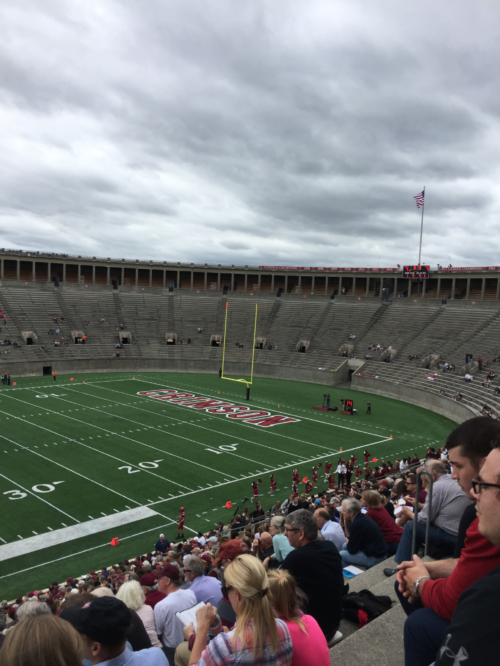Harvard-Cornell and its comparisons.
On Saturday afternoon, as I sat in the cool concrete stands of Harvard Stadium, my father texted me a photograph and a message. At the photo’s center was the University of Texas Longhorn Band, the “Showband of the Southwest” incarnate, marching across the green turf of the Cotton Bowl. They marched square as a Roman legion, bedecked from shoulder to heel in burnt orange fabric and white leather fringe, and a crowd of ninety-two thousand gazed down upon them. The fans were starkly divided into seas of orange and red as Texas squared off against Oklahoma. It was a down year for the two aristocrats of Big 12 football – both teams entered the game with a pair of losses – but it was still the Red River Shootout, with the State Fair of Texas waiting just outside the entry gates. My father captioned the picture “October in Texas,” and I found myself still thinking of that game and the coarse cries of carnival barkers and the hypnotic pummeling of saltwater taffy. The Harvard band then struck up a tune, so I snapped a picture of the mostly-empty bend in the horseshoe of Harvard Stadium. I captioned it “October in Massachusetts,” and sent it back to my old man.
I did it mostly to validate his own game-day experience, because I actually found myself well-pleased to be watching Harvard-Cornell. It was a matchup of the Ivy League’s last two unbeaten teams, a game slated to be Harvard’s last best home game until the Yale finale, and it came amidst an October afternoon where a long sleeve t-shirt was the order of the day. If the stadium was less than full with its crowd of eleven thousand, it was not on account of the weather or a lack of effort from the athletic department. Promotions abounded for the game. It was Community Day, with free entry for Allston, Brighton, and Cambridge residents, and it was also Youth Football day, with discounted rates for area youth teams. I was constantly reminded of this fact as junior high schoolers swarmed the concourses and stairs, their jerseys hanging loosely over unpadded shoulders, the names of assorted towns and animals rumpling proudly across the fronts.

The usual contingency of Boston Brahmins and college professors and geriatric Harvard grads sat needle-nosed in the late afternoon, and cheered tersely at first downs and scores. But more surprising was the crowd’s less rarefied element, men of that same strain of Boston fandom which continually renews the population of the bleacher seats at Sox games. They knew the names of the Harvard side, even had nicknames and abbreviations for a handful of players, and displayed a profound familiarity with all things Crimson football. This made it clear that they were probably not of the university crowd at all, but instead loyal subway alumni. They cheered so raucously and knowledgably that were it not for the shadow of a chill in the autumn air and the non-rhoticity of their lusty cries, one might have pegged them for the fans of a Southern state school. I found myself reminded of people who claimed their college allegiances not by forking over thousands for a degree, but by the simple dictates of geography and Wal-Mart sales. Those ranks usually bolstered Texas and Alabama, and I was pleasantly stunned that Harvard should have such support.
This development belied the steady climb of Harvard football to the upper echelons of the sport in New England, and they maintained that position in a chippy contest against Cornell. The teams traded touchdowns in the first quarter and roughing the passer penalties in the second, while Cornell was called for a personal foul early in the third. At halftime, the score stood 14-7 in Harvard’s favor, and they never relinquished the lead.
Towards the end of the Crimson’s 29-13 victory, the Harvard band entered the largely empty stands behind the southern endzone. Throughout the game, they and their Cornell counterparts had traded brassy haymakers, as Harvard blasted “Ten Thousand Men of Harvard” and Cornell riffed a number of variations on “Far Above Cayuga’s Waters”. At one point, a rogue subset of the Cornell band infiltrated the Harvard section, where they were met with the casual nonchalance of the Harvard band, the flustered directives of the stadium staff, and the general amusement of the spectators. Yet as the outcome became increasingly clear, a satellite of the Harvard troupe emerged from the stadium’s bowels and blared “Ode to Joy” as the clock wound down.
I whistled along as I walked the stadium’s upper row, and thought of the picture my father had sent me. I thought of how far a cry the Ivy League’s scramble bands were from the Showband of the Southwest, and how far a cry Harvard-Cornell was from Texas-OU, but the comparison did not trouble me. This was October in Massachusetts, after all, and it carried odes all of its own.
Jess Clay (jclay@college.harvard.edu) has come to contentedly reconcile his love of the two.

